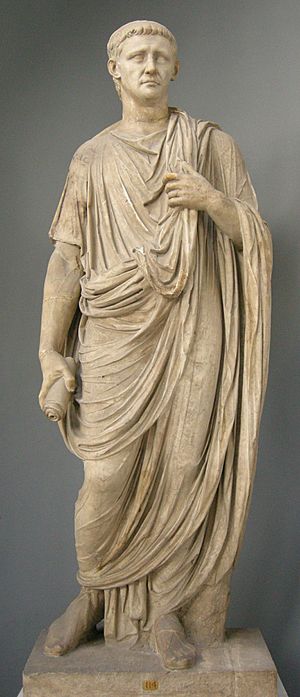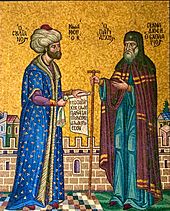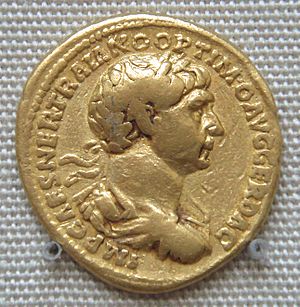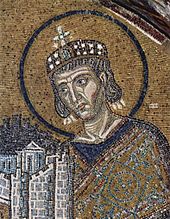Caesar (title) facts for kids

The word Caesar (pronounced SEE-zer) is a special title that means something like "emperor" or "ruler." It comes from the famous Roman leader Julius Caesar. Over time, this family name became a title used by the Roman Emperors. This change happened around the years 68-69 AD, during a time known as the "Year of the Four Emperors."
Contents
How "Caesar" Became an Imperial Title

After Julius Caesar died, his adopted son, Augustus, became the first Roman Emperor. Augustus wanted to show his connection to Julius Caesar, so he called himself "Imperator Caesar." The Roman Senate later added the honorable name Augustus, meaning "Majestic" or "Venerable."
Augustus's stepson, Tiberius, who became the next emperor, also used the name "Caesar." This set a pattern: future emperors would often adopt their chosen successor and give them the name "Caesar." This showed everyone who would rule next.
The fourth Emperor, Claudius, was the first to use "Caesar" as a title when he became emperor, even though he wasn't adopted by the previous emperor. However, he was still part of the Julio-Claudian dynasty, being related by blood to earlier emperors. Claudius then adopted his own stepson, who later became Emperor Nero, and gave him the name "Caesar" in the usual way.
The first emperor to take the name "Caesar" without a strong family claim was Galba. He became emperor after Nero died in 68 AD. Galba helped make "Caesar" a clear title for the person chosen to be the next emperor by giving it to his own adopted heir.
Later, Emperor Vespasian brought back the importance of the "Caesar" title. His son, Titus, became "Titus Caesar Vespasianus." This showed that "Caesar" was a key part of being an emperor or a future emperor.
"Caesar" as a Title for Future Emperors
By this time, "Caesar" was a regular title given to the person who was expected to become the next emperor. This person was sometimes also called Princeps Iuventutis, meaning "Prince of Youth." When they became emperor, they kept the title. For example, Trajan was named Caesar Nerva Traianus before he became Emperor.
On coins, the future emperor was often called Nobilissimus Caesar, which means "Most Noble Caesar." Sometimes, just "Caesar" was used.
Later Roman Empire
In the later Roman Empire, the title "Caesar" was also used for a junior ruler who shared power with a senior emperor. This happened in break-away parts of the empire too, where they wanted to copy the main Roman system. For example, the last Gallic emperor gave the title to his son.
The Tetrarchy System
Around 293 AD, Emperor Diocletian created a new system called the Tetrarchy. This meant the empire was ruled by four people:
- Two senior emperors, called Augusti. They had titles like "Pious and Blessed" and "Unconquered."
- Two junior emperors, called Nobilissimus Caesar. These were the future emperors.
When a junior "Caesar" became a senior "Augustus," they kept the "Caesar" part of their name. This system of four rulers didn't last long, but the idea of having senior and junior emperors continued in both the Latin-speaking West and the Greek-speaking East.
Byzantine Empire
In the East, which we now call the "Byzantine Empire," the title kaisar (the Greek word for Caesar) was still important. A kaisar wore a special crown and was a high-ranking prince or a chosen successor to the emperor.
Over time, more people were given the kaisar title. So, Emperor Alexios I Komnenos created an even higher title called Sebastokratôr for his brother. This new title meant "Majestic ruler." Later, another emperor, Manuel I Komnenos, created a third, even higher title called Despotes. Unlike the kaisar and Sebastokratôr, the Despotes often ruled over a specific area. These new titles were created to show different levels of importance in the royal family.
Ottoman Empire

After conquering Constantinople in 1453, the Ottoman Sultan Mehmed II took the title "Caesar of the Roman Empire." In the Ottoman language, this was Kayser-i-Rûm. Mehmed II didn't see "Caesar" as a minor title, but as the grand title of the great emperors of the past.
By taking this title, the Ottoman Empire suggested that it was the new continuation of the Roman Empire. This idea was not shared by people in Western Europe. As "Caesar of the Roman Empire," Mehmed II also brought back the main church leader of Constantinople, the Ecumenical Patriarch.
Images for kids
See also
 In Spanish: César (título) para niños
In Spanish: César (título) para niños




